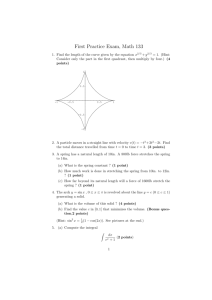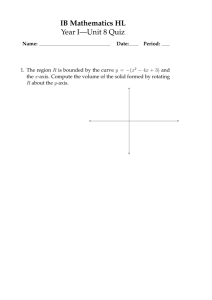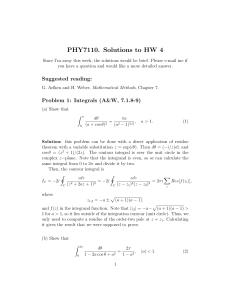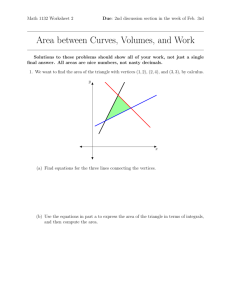1. Change the order of integration, you don't need to compute the
advertisement
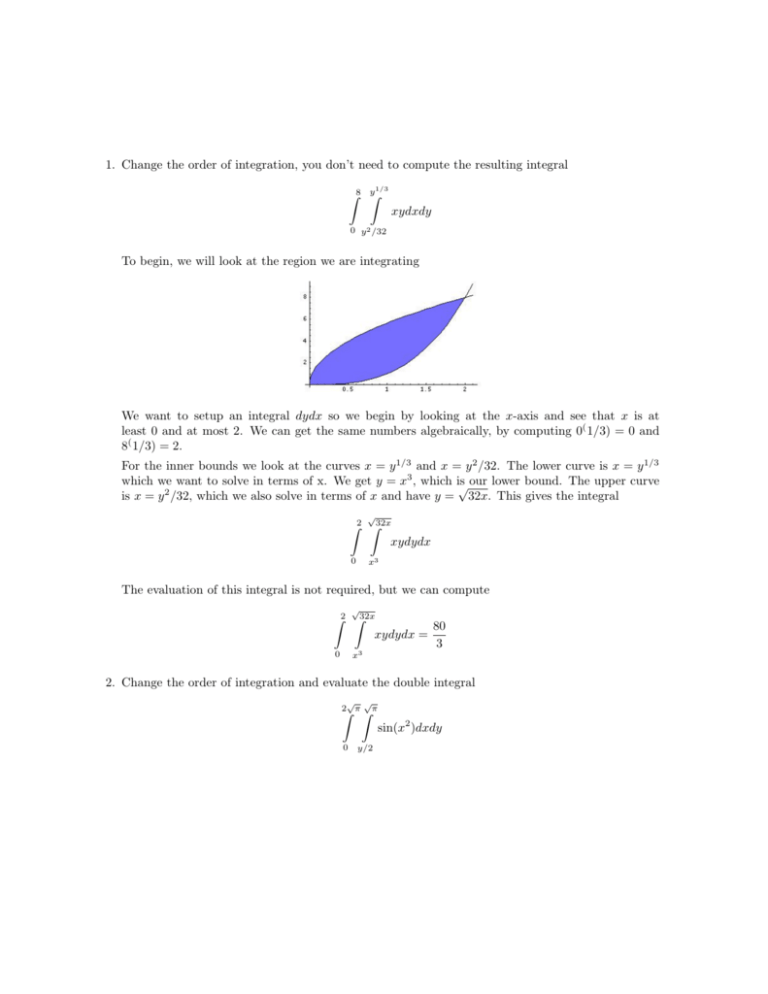
1. Change the order of integration, you don’t need to compute the resulting integral 1/3 Z8 yZ xydxdy 0 y 2 /32 To begin, we will look at the region we are integrating We want to setup an integral dydx so we begin by looking at the x-axis and see that x is at least 0 and at most 2. We can get the same numbers algebraically, by computing 0( 1/3) = 0 and 8( 1/3) = 2. For the inner bounds we look at the curves x = y 1/3 and x = y 2 /32. The lower curve is x = y 1/3 which we want to solve in terms of x. We get y = x3 , which is √ our lower bound. The upper curve is x = y 2 /32, which we also solve in terms of x and have y = 32x. This gives the integral √ Z2 Z32x xydydx 0 x3 The evaluation of this integral is not required, but we can compute √ Z2 Z32x 80 xydydx = 3 0 x3 2. Change the order of integration and evaluate the double integral √ √ 2Z π Z π 0 y/2 sin(x2 )dxdy As usual, we begin by sketching the region of integration. To reverse the order of integration, we must setup the integral dydx we can tell in the picture that √ x is bounded by 0 and π, and y is bounded by 0 and 2x. This allows us to reverse the order of integration √ Z πZ2x sin(x2 )dydx 0 0 We can now evaluate this integral √ Z πZ2x 0 √ sin(x2 )dydx = 0 Zπ 2x ! dx = sin(x2 )y 0 0 √ Zπ sin(x2 )2xdx = 0 √π = − cos(x2 ) = 2 0 Notice that we could not have made the u substitution before changing the order of integration. 3. Consider but do not evaluate the integral Z2 √ Z4−x2 √ 4−x2 −y 2 Z 2dzdydx √ −2 − 4−x2 0 (a) What is the region of integration? The region of integration is the section of the sphere of radius 2 given by x2 + y 2 + z 2 = 4 with z ≥ 0. In particular it is a hemisphere centered at (0, 0, 0) located entirely above the xy plane. (b) Can you find the value of this integral without integrating? This integral we can compute without any knowledge of calculus. The value of the integral will be twice the volume of a hemisphere. The area of a hemisphere will be half the volume of a sphere. The volume of a sphere of radius r is given by 4 3 πr 3 V = So the value of the integral will be 2· 1 4 32π · 8π = 2 3 3 4. Let W be the region that lies below the plane z − 2y = 4 and above the triangle in the xy-plane given by x ≤ 1, y ≤ 2 and y + 2x ≥ 2. Setup a triple integral giving the volume of W. We are integrating the to find the volume under a plane bounded by a region in the xy plane. As such already know we will integrate the function f (x, y, z) = 1, and know inequalities for z.First, we rewrite the equation of the plane for z in terms of y. z = 4 + 2y Now we know 0 ≤ z ≤ 4 + 2y This leaves the xy plane to deal with. The region in the xy plane is shown below. Although it won’t matter, we will chose to compute this integral dzdydx, so we look at the bounds on y, which can vary from y = 2 − 2x to y = 2, giving the bounds 2 − 2x ≤ y ≤ 2 Finally, we look at x and try to find constant bounds. Using the picture these bounds are easy to see. 0≤x≤2 So we can setup the integral Z2 Z2 4+2y Z 1dzdydx 0 2−2x 0 Which is not an overly difficult integral Z2 Z2 4+2y Z Z2 Z2 4 + 2ydydx = 1dzdydx = 0 2−2x 0 2−2x 0 Z2 2 4y + y = = dx = 2−2x 0 Z2 ! 2 16x − 4x2 dx = 8x2 − 0 2 64 4x3 = 3 0 3 5. Compute the arc length of the following paths √ (a) c(t) = (t, t2 / 2, t3 /3) with 0 ≤ t ≤ 2 To begin, we must compute c0 (t) 2t c0 (t) = (1, √ , t2 ) 2 And we will compute the magnitude of this vector r p 4t2 0 |c (t)| = 1 + + t4 = (1 + t2 )2 = 1 + t2 2 Finally, we will integrate the magnitude Z2 1 + t2 dt = 14/3 0 (b) c(t) = (2t3/2 , 3t, t) with 1 ≤ t ≤ 5. To begin, we must compute c0 (t) c0 (t) = (3t1/2 , 3, 1) And we will compute the magnitude of this vector √ |c0 (t)| = 9t + 9 + 1 Finally, we will integrate the magnitude Z5 √ 9t + 10dt = √ −10 √ 2 10 − 11 55 27 0 (c) c(t) = (e−t cos(t), e−t sin(t)) with 0 ≤ t ≤ 2π. To begin, we must compute c0 (t) p0 (t) = −e−t cos(t) − e−t sin(t), e−t cos(t) − e−t sin(t) = −e−t (cos(t) + sin(t)), e−t (cos(t) − sin(t)) Now we can setup and compute the integral Z 2π p (−e−t (cos(t) + sin(t)), e−t (cos(t) − sin(t))) · (−e−t (cos(t) + sin(t)), e−t (cos(t) − sin(t)))dt = 0 Z = 2π √ 2e−2t dt = 0 √ Z 2π −t = 2 e dt = √ 0 = 2 1 − e−2π 6. Sketch the following vector fields, compute the scalar curl and divergence of each field. (a) G(x, y) = (y 2 , y) The scalar curl of this vector field is ∂ ∂ (y) − y 2 = −2y ∂x ∂y The divergence is ∂ ∂ y2 + (y) = 1 ∂x ∂y (b) F (x, y) = (x2 , y) The scalar curl of this vector field is ∂ ∂ (y) − x2 = 0 ∂x ∂y The divergence is ∂ ∂ x2 + (y) = 2x + 1 ∂x ∂y (c) H(x, y) = (−1/x, −1/y) The scalar curl of this vector field is ∂ ∂x −1 x ∂ − ∂y −1 y =0 The divergence is ∂ ∂x −1 x ∂ + ∂y −1 y = 1 1 + 2 2 x y 7. Let F (x, y, z) = (x + y, y + z, x + z) be a vector valued function, compute the divergence and curl of F To give a better feel for the vector field, here is a plot of the vector field. Computing the divergence of the vector field. divF = ∇ · F = ∂F1 ∂F2 ∂F3 + + =1+1+1=3 ∂x ∂y ∂z We compute the curl as the cross product curlF =∇ × F~ ∂ ∂ ∂ , , × (F1 , F2 , F3 ) = ∂x ∂y ∂z i j k ∂ ∂ ∂ =det ∂x ∂y ∂z F1 F2 F3 In our specific problem we know that F1 (x, y, z) =(x + y) F2 (x, y, z) =(y + z) F3 (x, y, z) =(x + z) Which gives us the specific formula curl F = i j k ∂ ∂x ∂ ∂y ∂ ∂z x+y y+z x+z Evaluating this determinant gives us the vector (−1, −1, −1)

